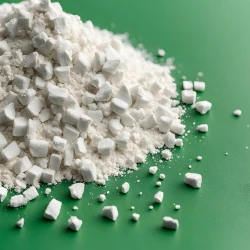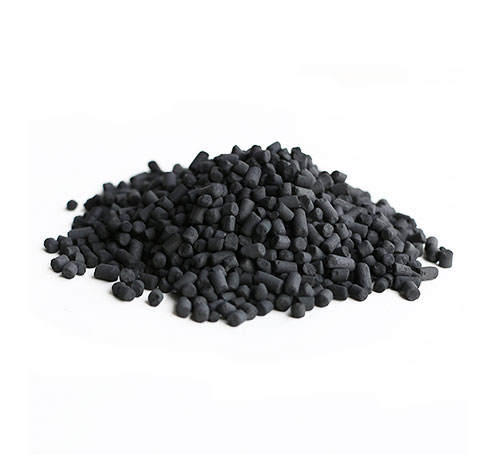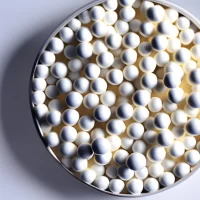Tabular alumina, a high-purity form of aluminum oxide (Al₂O₃), emerges as a material of exceptional significance within the realm of advanced materials science.
Renowned for its unique crystalline structure, tabular alumina stands out as a key player in various industrial applications, showcasing remarkable properties that set it apart from conventional alumina forms.
This introduction delves into the distinctive characteristics of tabular alumina, exploring its role in high-temperature environments, refractory engineering, ceramics, and abrasives.
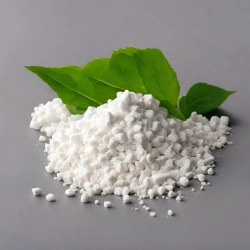
Contents
What we will talk about in this article?
Tabular Alumina
Tabular alumina is a high-purity form of alumina (aluminum oxide, Al₂O₃) that is characterized by its unique crystalline structure and exceptional properties. Here is some information presented in a tabular format:
| Property | Description |
|---|---|
| Chemical Formula | Al₂O₃ |
| Crystal Structure | Tabular (large, flat, hexagonal platelet crystals) |
| Purity | Typically 99% or higher |
| Density | 3.5 - 3.7 g/cm³ |
| Melting Point | Approximately 2,072°C (3,762°F) |
| Hardness (Mohs) | 9 |
| Thermal Expansion | Low |
| Thermal Conductivity | Relatively low |
| Applications | - Refractory materials (high-temperature applications) |
| - Abrasives and grinding media | |
| - High-performance ceramics | |
| - Foundry applications | |
| Advantages | - High-temperature resistance |
| - Excellent thermal shock resistance | |
| - High mechanical strength | |
| - Low porosity | |
| - Chemical inertness |
Tabular alumina's distinctive characteristics make it a preferred material in applications where high-temperature resistance, thermal shock resistance, and mechanical strength are crucial. Its use in refractory materials, abrasives, and high-performance ceramics contribute to various industries, including metallurgy, foundries, and ceramics manufacturing.
The low porosity and chemical inertness of tabular alumina enhance its performance in challenging environments. As technology continues to advance, tabular alumina remains a key component in the development of materials that can withstand extreme conditions.
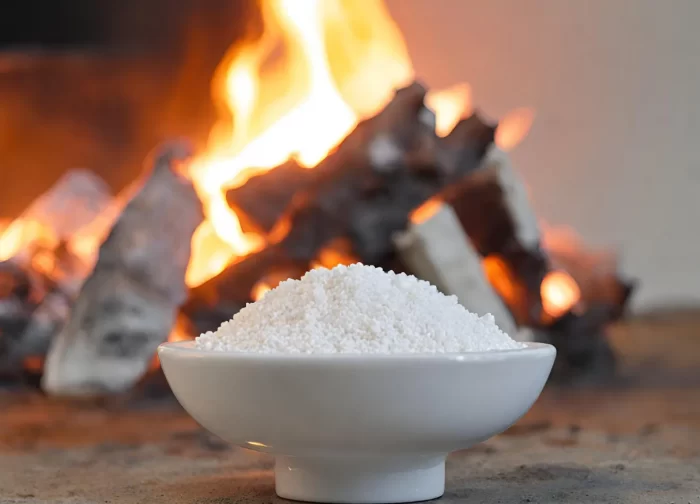
Tabular Alumina Uses
Tabular alumina finds diverse applications across various industries owing to its unique properties, making it a valuable material in different contexts. Some of the primary uses of tabular alumina include:
Refractory Applications:
- Furnace Linings: Tabular alumina's high-temperature resistance and low porosity make it an ideal material for constructing furnace linings in industries such as metallurgy and steel production.
- Cement and Castables: It is used in refractory cements and castables to enhance their performance in high-temperature environments.
Ceramics Manufacturing:
- Advanced Ceramics: Tabular alumina contributes to the production of advanced ceramics, including wear-resistant components, insulating substrates, and components for electronic devices.
Abrasives and Grinding Media:
- Grinding Wheels: Its exceptional hardness makes tabular alumina a key component in the manufacturing of high-performance grinding wheels used for precision grinding in industries such as metalworking.
- Abrasives: Tabular alumina is used as an abrasive material in various applications, including abrasive papers and polishing compounds.
Foundry Applications:
- Foundry Sands: Tabular alumina is utilized in foundry applications as part of sands and refractory materials to enhance the casting process and improve the quality of metal castings.
High-Temperature Insulation:
- Insulating Materials: Tabular alumina's thermal stability makes it suitable for use in high-temperature insulation materials, contributing to the efficiency of insulation in various industrial processes.
Catalyst Support:
- Catalyst Manufacturing: Tabular alumina is employed as a support material in catalysts for various chemical processes due to its inert nature and stability.
High-Tech Industries:
- Electronics: Tabular alumina is used in the production of ceramic substrates and components for electronic devices, benefiting from its high thermal conductivity and electrical insulating properties.
Construction Materials:
- High-Strength Concrete: In construction, tabular alumina may be incorporated into high-strength concrete formulations to enhance the material's resistance to high temperatures and improve overall durability.
The versatility of tabular alumina across these applications underscores its importance as a high-performance material, contributing significantly to the advancement and efficiency of various industries.
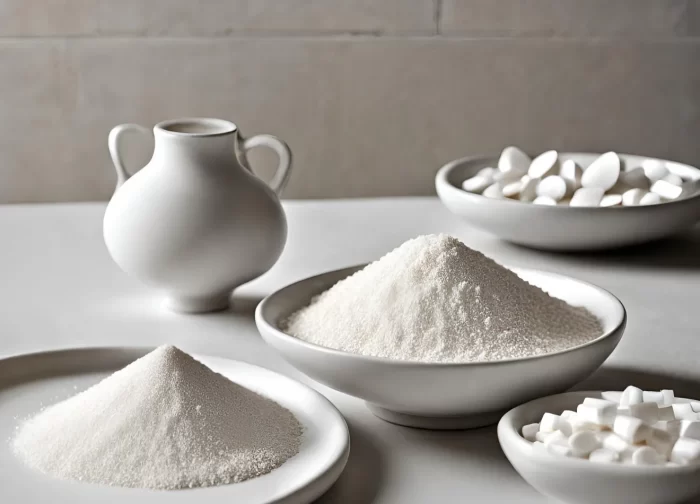
Tabular Alumina Manufacturing Process
The manufacturing process of tabular alumina involves several key steps, transforming raw materials into the high-purity crystalline structure that characterizes tabular alumina. The process typically includes the following stages:
Raw Material Selection:
- The process begins with selecting high-purity raw materials, usually aluminum hydroxide or bauxite, to ensure the resulting tabular alumina meets the desired specifications.
Calcination:
- The selected raw materials undergo calcination, a high-temperature heating process in rotary kilns or shaft kilns. During calcination, the raw materials are heated to temperatures above 1,700°C (3,092°F) to remove impurities, water, and other volatile components.
High-Temperature Treatment:
- After calcination, the intermediate product is subjected to additional high-temperature treatment, often in a high-temperature electric arc furnace. This process further refines the alumina, promoting the development of a tabular crystalline structure.
Crushing and Grinding:
- The resulting material is then crushed and ground into fine particles. This step is crucial for achieving the desired particle size distribution and improving the overall characteristics of tabular alumina.
Shaping and Forming (Optional):
- In some cases, the tabular alumina particles may undergo shaping or forming processes to create specific shapes or structures tailored to the intended application. This can include the formation of pellets or other specialized forms.
Sintering:
- Sintering is a process where the shaped or crushed alumina particles are subjected to high temperatures, typically around 1,800°C (3,272°F), in order to achieve final densification and further enhance the crystalline structure.
Quality Control:
- Throughout the manufacturing process, rigorous quality control measures are employed to ensure that the tabular alumina meets the desired specifications. This includes monitoring the chemical composition, particle size distribution, and other relevant properties.
Packaging and Distribution:
- Once the tabular alumina has undergone the necessary processing and quality checks, it is packaged and prepared for distribution to industries and manufacturers that utilize it in various applications.
It's important to note that specific manufacturing processes may vary among producers, and advancements in technology may lead to variations in the methods employed. However, the fundamental principles of high-temperature treatment, purification, and quality control remain integral to the production of tabular alumina.

Brown Tabular Alumina
Brown tabular alumina is a specific type of tabular alumina characterized by its brown or tan color. It shares many of the properties of white tabular alumina. Still, it may have slightly different characteristics due to variations in the raw materials and manufacturing process. Here are some critical aspects of brown tabular alumina:
Color:
- Brown tabular alumina has a distinctive brown or tan color, which is a result of impurities in the raw materials used during the manufacturing process.
Composition:
- Like other forms of tabular alumina, brown tabular alumina is primarily composed of aluminum oxide (Al₂O₃). The specific composition may vary depending on the raw materials used and the manufacturing process.
Crystalline Structure:
- Brown tabular alumina retains the tabular crystalline structure that is characteristic of tabular alumina. This structure contributes to its high strength, hardness, and thermal shock resistance.
Applications:
- Brown tabular alumina is often used in applications where its properties, including high-temperature resistance and mechanical strength, are beneficial. Typical applications include refractory materials, abrasives, and ceramics.
Refractory Applications:
- It is utilized in the production of refractory materials for applications such as furnace linings, where its resistance to high temperatures and thermal shock is advantageous.
Abrasive Applications:
- Brown tabular alumina is employed in the manufacturing of abrasive products, including grinding wheels and abrasive papers, where its hardness and durability are valuable for precision grinding.
Foundry Applications:
- In foundries, brown tabular alumina can be used in various applications to enhance the quality of castings and contribute to the efficiency of the casting process.
Chemical Inertness:
- Similar to other forms of tabular alumina, the brown variant is chemically inert, making it suitable for applications where resistance to chemical corrosion is essential.
It's important to note that while brown tabular alumina shares some common properties with white tabular alumina, the specific applications and use cases may vary based on the material's color and impurity content. The choice between brown and white tabular alumina depends on the requirements of the intended application.

Conclusion
Tabular alumina stands as a crucial player in the materials landscape, distinguished by its unique crystalline structure and exceptional properties.
With high-temperature resistance, mechanical strength, and versatility across refractory, ceramic, and abrasive applications, tabular alumina proves to be an indispensable component in various industries.
Its reliability, adaptability, and contribution to cutting-edge technologies emphasize its ongoing significance in advancing materials science and industrial processes.
